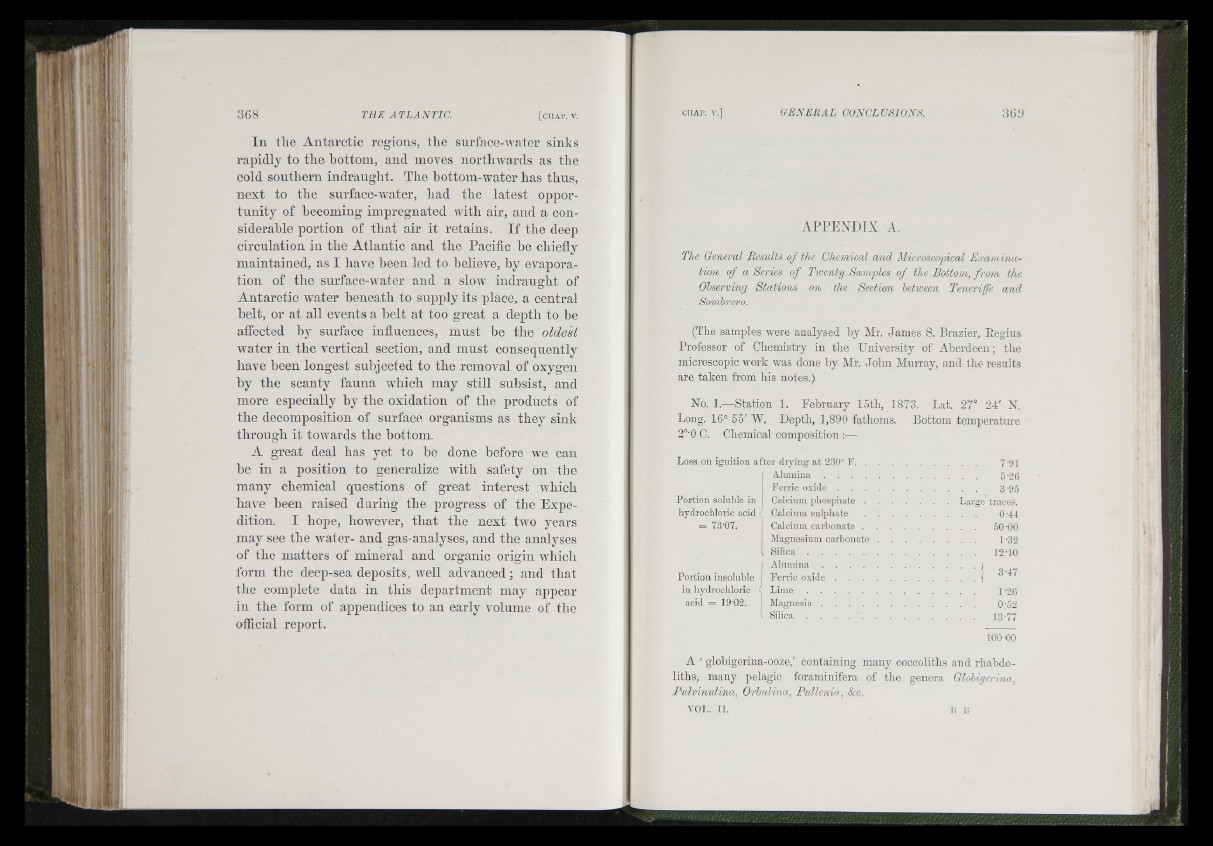
Üg
- i
I i
G ]
i ' l (
■Ili 1: f
■‘i "
lSiii . iI
;d||il::l
f :
■i*.‘
fl i ■G
jii I
i ' ‘
In the Antarctic regions, the surface-Avater sinks
rapidly to the bottom, and moves nortliAvards as tbe
cold southern indraught. Tbe bottom-Avater has thus,
next to tbe snrface-Avater, bad tbe latest opportunity
of becoming impregnated vA'ith air, and a considerable
portion of tb a t air it retains. I f tbe deep
circulation in tbe Atlantic and the Pacific be chiefly
maintained, as I liaA'e been led to believe, by evaporation
of tbe surface-Avater and a s I oav indrauscht of
Antarctic Avater beneath to supply its place, a central
belt, or at all events a belt at too great a depth to be
affected by surface influences, must be the oldest
Avater in tbe vertical section, and must consequently
liave been longest subjected to the removal of oxygen
hy the scanty fauna which may still subsist, and
more especially by the oxidation of the products of
the decomposition of surface organisms as they sink
through it towards the hottom.
A g r e a t d e a l h a s y e t to h e done h e fo re we c an
h e in a p o s itio n to g e n e ra liz e w ith sa fe ty o n th e
m a n y ch em ic a l q u e s tio n s o f g r e a t in te r e s t Avhich
liaA'e h e en ra is e d d u r in g th e p ro g re s s o f th e E x p e d
itio n . I h o p e , lioweA'er, th a t th e n e x t tw o y e a rs
m a y see th e Avater- a n d g a s -an a ly se s, a n d th e an a ly se s
o f th e m a tte r s o f m in e ra l a n d o rg a n ic o rig in AA'hich
fo rm th e deep-sea dep o sits, Avell ad v an c ed ; a n d th a t
th e com p le te d a ta in th is d e p a r tm e n t m a y a p p e a r
in th e fo rm o f ap p en d ic e s to a n e a rly v o lum e o f th e
official re p o rt.
APPENDIX A.
The General Eesults o f the Chernical and Microscoincal Examination
of a Series o f Twenty Samples of the Bottom, from the
Observing Stations on the Section betiveen Teneriffe and
Sombrero.
(The samples were analysed by Mr. James S. Brazier, Piegius
Professor of Chemistry in the University of Aberdeen; the
microscopic work was done by Mr. John Murray, and the results
are taken from his notes.)
No. 1.— Station 1. February 15th, 1873. Lat. 27° 24' N.
Long. 16° 55' W. Depth, 1,890 fathoms. Bottom temperature
2°'0 C. Chemical composition :—
Loss on ignition after drjnng at 230” F.
Alumina
Ferric oxide .
Calcium phosphate
Calcium sulphate
Calcium carbonate
Portion soluble in
hydrochloric acid
= 7.3-07.
Magnesium carbonate
Portion insoluble
in hydrochloric
acid = 19'02.
Silica . .
Alumina
Ferric oxide
Lime
Magnesia .
Silica
. . 7-91
. . 5-26
. . 3-95
Large traces.
. . 0-41
. . 50-00
1-32
. . 12-10
3-47
1-26
0-52
13-77
100-00
A ‘ globigerina-ooze,’ containing- many coccoliths and rhabdo-
liths, many pelagic foraminifera of the genera Globigerina,
Pulvinulina, Orbulina, Pullenia, &c.
VOL, 11. li I!